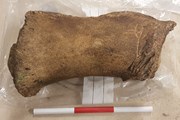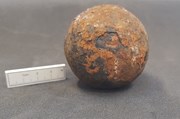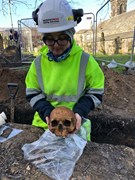
17 Jun 2020
LATEST NEWS: Rare whale bones amongst historical discoveries made in tram project excavations

- Whale bones, a cannonball and historic human remains amongst finds
- Archaeologists also found potential evidence of the area's 16th and 17th century fortifications
- The team are now resuming their work to explore Leith's heritage as the project recommences
An assortment of historic artefacts unearthed around Constitution Street as part of the Trams to Newhaven project, along with archaeological investigations, have shed new light on the area’s history.
The relics, discovered during excavations carried out earlier this year in preparation for the tram works, range from rare whale bones to a cannonball thought to date back to the 17th century, as well as possible remnants of Leith’s 16th/17th century town defences.
Investigations also revealed evidence which could suggest the reclamation of parts of Leith foreshore – when land was extended into the Forth – happened earlier than first thought.
Now, as we prepare to begin the project’s main construction works on Leith Walk, as well as resuming excavations, archaeologists from GUARD Archaeology Ltd, who are undertaking work on our behalf under swept path contractors Morrison Utility Services, have shared images and their analyses of the remains found so far, which include:
- Whale bones: Found on Constitution Street to the north of its junction with Baltic Street, a matching radius and ulna (part of the fin) of a large adult male sperm whale. The bones have yet to be carbon dated (this has been delayed due to the coronavirus pandemic), which will help explain how they ended up under the pavement in Leith. Amongst possible theories are that they were brought back in the 19th or 20th century as a memento as part of Leith’s historic whaling industry, that they came from the remains of a whale beached locally and were subsequently dumped there or that they were part of medieval deposits left there during the reclamation of the site in the 17th to 19th centuries, perhaps dating back to the medieval period.
- Cannonball: A small iron cannonball found in Constitution Street thought to date back to the 17th century - of a type used around the time of the Civil War when Constitution Street and Leith was refortified.
- Historic drainage: Excavations between Bernard Street and Tower Street have revealed important evidence relating to the reclamation of the area, including a large system of 19th century interlinked brick and stone box-drains, 18th century walls and a possible slipway. Evidence of 17th century clay pipes also indicates that the reclamation of the area could have occurred earlier than first thought.
- Town defences: Prior to lockdown the heavily truncated remains of a large stone wall were discovered running east to west under the junction of Bernard Street and Constitution Street. This may be part of the seawall for the 16th and 17th century town fortifications – the team will be investigating this when the project restarts.
Council Leader Adam McVey said:
“Leith has a fantastically rich heritage but these discoveries continue to expose new aspects of its fascinating, varied history.
“I’m pleased that the team will now be able to resume their work as part of the project, which is vital to conserving the area’s past, and look forward to finding out even more as they progress.”
Depute Leader Cammy Day said:
“The Trams to Newhaven project is crucial to the long-term development of the city and this area in particular, helping to deliver much needed housing, jobs and investment for the future. As part of its delivery, it’s fitting that we also learn more about Leith’s past, as these remarkable findings are helping us to do.”
City Archaeologist John Lawson said:
“Our work to excavate the area as part of preparatory work for the Trams to Newhaven project has offered really interesting glimpses into the area's history, over the past three to four hundred years, and we’re endeavouring to conserve that.
“Discoveries like the whale bones have been particularly fascinating and exciting. These bones provide a rare glimpse into and also a physical link with Leith’s whaling past, one of its lesser known maritime industries and one which in the 20th century reached as far as the Antarctic. Given the circumstances of how they were found it is possible that they may date back to the medieval period, and if so would be a rare and exciting archaeological discovery in Edinburgh.”
Bob Will of GUARD Archaeology Ltd added:
“The Trams project will allow us to discover more about the history and development of Leith from the medieval period to the modern day. The work so far has already uncovered a range of exciting objects with a cannonball and the whale bone.”
Archaeological work began on Constitution Street in November 2019 and was stopped at the end of March, along with the wider project, to comply with Government guidance and to protect the safety of workers and residents in light of the coronavirus outbreak.
During the first phase, the team also took down part of a wall surrounding Constitution Street Graveyard, dating back to 1790, ahead of excavation of the historic graveyard thought to be underneath Constitution Street and the South Leith Parish Church wall. Preparatory work to recover any human remains, led archaeologists to discover what appears to be a large charnel pit which may contain the remains of some burials recovered from the laying of 19th century services in Constitution Street. This will be further investigated when works recommence.
In line with Scottish Government guidance, construction resumed on existing sites on Lindsay Road, Melrose Drive and Constitution Street this week, along with preparatory works on Leith Walk. Main construction works on Leith Walk from Elm Row to Crown Place will start on Monday, 22 June.
Traffic management will be installed on the evening of Friday, 19 June and will be operational from 5am on Saturday, 20 June, including Lothian Buses diversions. This will involve Leith Walk being reduced to one city bound lane between London Road and Crown Place for the duration of the works.
All works, including archaeological investigations, will be carried out while maintaining physical distancing and with additional measures to protect workers’ and the public’s health in place.
Find out more about Trams to Newhaven on the project website.
Contact Information
Rebecca Gordon
rebecca.gordon@edinburgh.gov.uk






